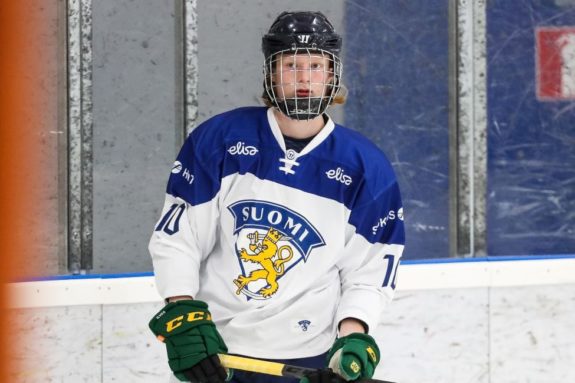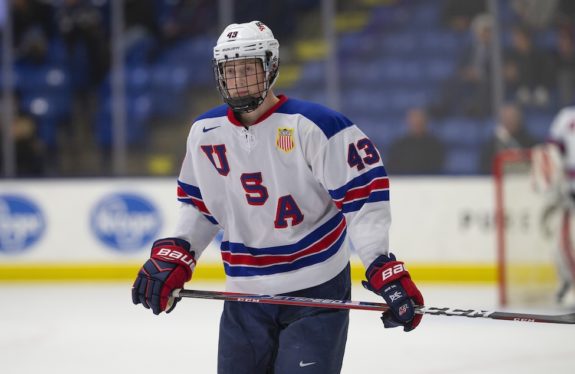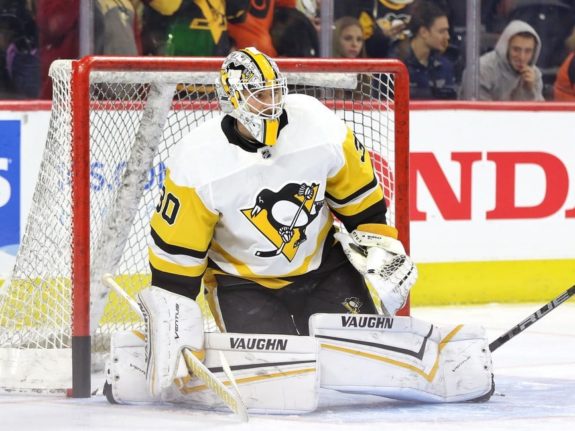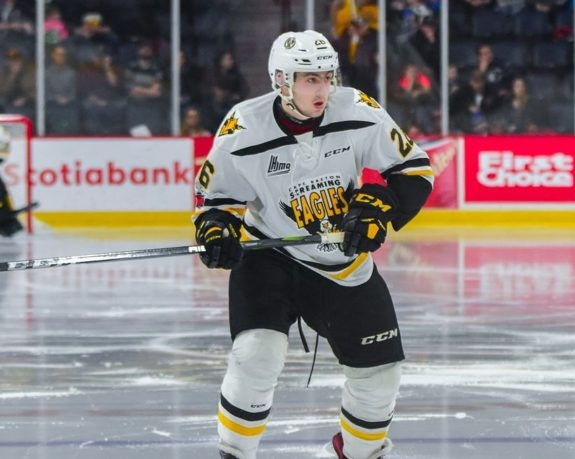The Ottawa Senators began their 2020 draft with class, having long-time Jeopardy host Alex Trebek announce the first pick, Tim Stützle. They then surprised with the selection of Jake Sanderson at fifth and finished with taking Ridley Grieg at 28th overall. It was a strong first day and the players added will likely be cornerstones for the franchise moving forward.
Related: Senators Add Skill, Size & Grit on Day 1
With such a successful start, the excitement was high as the Senators entered Day 2 of the 2020 NHL Draft. Armed with four second-round picks and two more thirds, the team seemed to be in the perfect place to grab some of the elite talent that had fallen out of the first round. Noel Gunler, Helge Grans, J-J Peterka, Roni Hirvonen, and Thomas Bordeleau, among others, were all ripe for the taking.
Yet the Senators had a different plan. They looked at their prospect depth and thought that the biggest gap wasn’t high-end skill, but size and strength. So, instead of grabbing boom-or-bust prospects, they went for safer, more established players who mostly have a shot at becoming depth players in the NHL, with a few minor exceptions.
33 – Roby Järventie, LW
The Senators’ first pick on was a bit of a surprise to many of those watching, but it shouldn’t have been. Järventie was one of the best Finnish prospects entering the draft and received some consideration as a potential late first-round pick. He’s a modern power forward, scoring big goals and playing with a slight edge. Last season in Finland’s Mestis, he scored 23 goals in 36 games and added 56 penalty minutes. This season, Järventie has a goal and an assist in two games in the Liiga, Finland’s top professional league. That’s a very impressive start for the teenager who just turned 18 in August.

The pick follows a trend that began to develop after the Senators’ pick of Grieg – the team wants to get stronger. Järventie is a few seasons away from making an impact in North America, but he is already showing glimpses of becoming a dangerous top-six forward, but should at least become a versatile middle-six scoring threat. Spending time with Finland’s top league will give him plenty of opportunities to develop some more strength and add some bulk to his 6-foot-2 frame. This is a great pickup by the Senators, even if it was a name many didn’t recognize.
44 – Tyler Kleven, D
After trading their 59th and 64th picks to the Toronto Maple Leafs for the 44th selection, not many expected the Senators to take Kleven. The big defenseman played for the United States Development Program last season, where he demonstrated the ability to move the puck smoothly, fire heavy one-timers, and use his 6-foot-4 frame to shut down opposing forwards. He’s committed to attend the University of North Dakota this coming season, where he’ll join friend, former teammate, and Senators’ top pick Sanderson.

The pick is reminiscent of 2018, when the Senators selected Jacob Bernard-Docker in the first round, then selected his former AJHL and future UND teammate, Jonny Tychonick, in the second round. They passed on the likes of Calen Addison and Sean Durzi, but they valued the relationship the two had and hoped it would pay off in the future. For Bernard-Docker, it most certainly has, as he’s emerged as one of the team’s best prospects and has a good chance to make the team sooner rather than later.
It’s also notable that the addition of Kleven gives North Dakota four Senators’ prospects for 2020-21: Bernard-Docker, Sanderson, and Shane Pinto. Having so many top prospects play for the same organization is a great way to develop early chemistry with teammates, and it’s a strategic move on the Senators’ part. While Kleven wasn’t the best pick they could have made – Jan Mysak, who some considered a top-15 pick, was still not he board – but it was a strategic selection that could pay off well later down the road.
52 – Traded for Matt Murray
After the news broke that Anders Nilsson was still struggling with concussion symptoms, the Senators’ need for a starting goalie became even direr after the departure of aging Craig Anderson. Murray had long been on the trade block and linked to the Senators before, but many were wondering what the two-time Stanley Cup Champion would cost. Apparently, all it took was one of their four second-round picks and Jonathan Gruden, a mid-tier prospect.

In Murray, the Senators finally have a successor to Anderson as their uncontested starting goalie. He’s only 26 years old and ranks third among all Pittsburgh Penguins’ goalies with 117 wins and 11 shutouts. It’s a great pickup for the team, and though Murray will need a new contract before the 2020-21 season starts January 1, there’s very little risk in the move.
There’s also some fun historical context – in 1999, the Senators acquired a 25-year-old goalie from the Anaheim Ducks, who they had just acquired from the Penguins and had yet to suit up for the Ducks. That goalie was Patrick Lalime, and he helped turn the Senators into a true postseason threat from 2000 to 2004. While the two goalies are very different, the parallels are at least intriguing.
61 – Egor Sokolov, RW
After parting with a third-round pick to move up to select Kleven, the Senators spent their final second-round pick on Sokolov, a powerful Russian playing for the Cape Breton Eagles. He’s considered one of the best overage prospects available thanks to a huge 2019-20 season in the QMJHL, scoring 46 goals and 92 points. While he primarily is a shooter, he’s shown improvements in his overall game.

However, is Sokolov actually good, or is he just big and thus able to overpower the smaller and younger competition in the QMJHL? He stands 6-foot-4 and weighs in at 240 pounds, making him one of the biggest players taken this year. With size like that, it’s reasonable to wonder if he simply overpowered his opponents and may struggle in higher levels where he’s more evenly matched. He was passed over twice, after all.
Still, Sokolov obviously has some talent, and his stats in previous seasons were very respectable. In his rookie season in 2017-18, he scored 21 goals, which he followed up with 30 goals in 2018-19. While he may project to be more of a bottom-six forward, his size at least makes him a threat anywhere he plays. Hopefully, for the Senators, he pans out.
71 – Leevi Meriläinen, G
According to Eliteprospects.com, no one projected Meriläinen to be drafted this year. He split time between the U18 and U20 Kärpät teams in Finland last season and posted pretty good stats, but wasn’t either team’s starter. At the U20 level, he was stuck behind Finnish phenom Joel Blomqvist, who was taken 52nd overall by the Penguins with the pick acquired in the Murray deal. With the U18 team, however, he split duties with 16-year-old Niklas Kokko, ending the season with six less games but a slightly higher goals-against-average.
Related: Senators’ Rebuild Rides on Late Round Drafting Success
Meriläinen has decent size at 6-foot-2, but is rail-thin, even for a goalie, weighing in at just 159-pounds. He’s a long shot to make the NHL, and with several high-profile picks still on the board (Carter Savoie, Jeremy Poirier, and Zion Nybeck, to name a few), this gamble may not have been worth it. Hopefully, the scouts found a diamond in the rough here, as he has good stats so far this season, but we’ll have to wait and see.
155 – Eric Engstrand, LW
Another overaged prospect, much less is known about the Swedish Engstrand. He, like Sokolov, has great size, standing 6-foot-4 and weighing 212 pounds, and he’s got a great, booming shot. He also plays a much more aggressive, physical game, making him a terror in the Swedish J20 league. But the same questions emerge – is he good, or is he just big?
Another troubling fact is that Engstrand wasn’t ranked by almost anyone, meaning he should have been available later in the draft. Veeti Miettinen, projected to be a second-round pick, or Connor McClennon, expected to be taken in the third round, were both were still available, and though they are undersized, they oozed skill, especially in regards to scoring goals. They also both play right-wing, a position where the Senators are lacking some depth. Engstrand could end up surprising as a late bloomer, but with more proven talent on the board, this feels like a miss.
158 – Philippe Daoust, LW
At 6-foot-0 and 161 pounds, Daoust was the smallest player taken by the Senators on Day 2 and the second smallest for the team at the 2020 Draft (Grieg stands 5-foot-11). Despite a 2001 birthday, he was a rookie in the QMJHL last season, putting up 29 points in 58 games and playing a significant role despite his lack of experience. He could have played earlier, but no OHL opted to draft him, and so he signed with the Moncton Wildcats for 2019-20 after a season in AAA.
This is another player that, while he could be a late-bloomer, was taken ahead of some other, more interesting prospects. Alexander Pashin, an undersized Russian forward, was still waiting to hear his name called despite being ranked well within the top-100. There was also Austrian overage phenom Benjamin Baungartner, who almost single-handedly led the Austrian U20 team to a World Junior berth in 2021. Daoust brings an intriguing skill set that hasn’t been tested much yet, but with the talent available, the risk seems unnecessary.
181 – Cole Reinhardt, LW
With their final pick, the Senators grab one more overage prospect with Reinhardt in the sixth round. The left-winger was invited to the Colorado Avalanche rookie camp in 2018 after being passed over at that draft but was an early cut. Since then, he’s made some big improvements, becoming one of the WHL’s best goal scorers. In 2019-20, he had just 55 points, but a whopping 31 goals, the 17th-highest total in the league.
Unlike the previous overage selections, however, this one feels more appropriate. There’s a chance Reinhardt is simply a late-bloomer and turns into a great NHL player. It’s happened before – the Senators selected Mark Stone, also from the Brandon Wheat Kings, in the sixth round of the 2010 draft. The team also didn’t pass on any significant prospects with this selection. Even if he doesn’t pan out, this was the right time to take a risk.
Bigger is Not Always Better
The end result of Day 2 was, overall, disappointing. The Senators had an opportunity to take some big risks, grabbing very high-potential players that could have found a place in Ottawa. They had some big holes, especially on the right side, which they had several opportunities to address, but in the end, they seemed to go for size over potential.
That’s not to say the Senators didn’t get any talented players or address any needs. Järventie, Sokolov, and Reinhardt are proven goal-scorers, something the team needs more of from their prospects. Toughness is also a valued trait and has proven to win championships. It’s possible that Dorion has his eye on the near future rather than the long-term, so he went for bigger players with a more proven track record in junior leagues who have a higher chance to step into the NHL right away.
However, the skill they passed on is significant. While 2020 could be a turning point, adding several key depth scorers and grinders that helps them win their first Stanley Cup, it seems much more likely that fans look back on this draft with regret, wondering how the team passed on so many top prospects. At least the Senators got a starting goalie out of it.